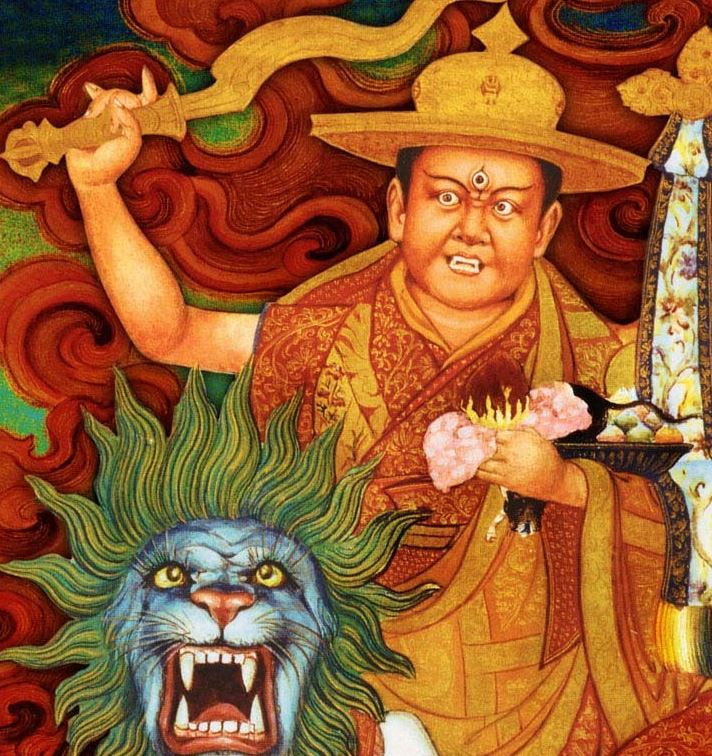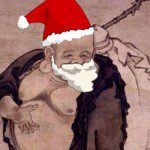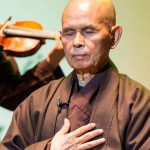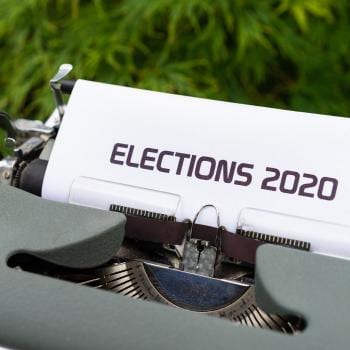For students of Tibetan Buddhism the Dorje Shugden issue is a treasure trove: involving a mysterious protector deity, capable of bestowing great wealth and threatening violence to foes, exposing a fault-line within the best known school of Tibetan Buddhism, with the widely-loved Dalai Lama caught in the middle, and now the secretive world of China-Tibet politics seeping in. For adherents to Tibetan Buddhism it exposes deeply held allegiances and the fears or concerns associated with potentially breaking century-old bonds of lineage. For secular Buddhists it points out how deeply problematic many traditional Buddhist beliefs and practices can be.
For those with time, the authoritative scholarly take on the Shugden Affair is the 1998 two-part article by Georges Dreyfus: The Shudgen Affair: Origins of a Controversy Part I (and Part II). My own brief summary of the controversy, originally posted last August after a wonderful panel discussion hosted by SOAS in London, is as follows:
Shugden, in short, is a ‘protector deity’ historically associated with the Geluk school of Tibetan Buddhism. His supposed power has led to great devotion by a number of esteemed Buddhist teachers, foremost among them Pabongkha Rinpoche (1878-1941), whose works helped shape Geluk thought and practice in the 20th century. However, while consistently asserting its political and religious dominance, the Geluk school was itself founded based on teachings from other schools and has a long history of adopting and endorsing practices from other schools.
This pluralistic tendency is, it seems, at the heart of the earliest phase of the ‘Shugden controversy’. This is because Shugden is said to oppose the incorporation of teachings from other schools. The matter is further complicated by the existence of lineages within schools whereby certain teachers, such as Pabongkha, will have students devoted to them and their teachings over and above others.
Meanwhile, the Dalai Lama, who has played both significant political and religious roles for the Tibetan Government in Exile, has sought to unify Tibetans of all schools. As such, he and others found it necessary to stop worshiping Shugden. The result has been a split in the Geluk school between a conservative group seeking to maintain Geluk purity or orthodoxy/orthopraxy, and others wishing to move toward greater inclusiveness. In part because the Dalai Lama is so greatly revered by Tibetans, the vast majority have sided with him and have stopped worshiping Shugden. Some have gone so far as to forbid Shugden worshipers from entering their shops, monastic institutions (with the Dalai Lama’s support), and medical facilities.
From there, things have become (even more) complicated, with a long list of accusations and counter-accusations with Shugden being associated with physical violence and tied to the murder of three monks in the late 1990s, and Shugden worshipers countering that the Dalai Lama, who they see as the source of the current controversy, is a fake and a liar.
(Also if you have time, do watch the presentations and read comments about that panel here.)
On to the Reuters Investigation
- We learn that though the title is bold and clear, the evidence is still murky and confused. While the title “China co-opts a Buddhist sect in global effort to smear Dalai Lama” and introduction, “The Dorje Shugden movement gets clandestine support from the Communist Party” are clear and confident, the investigation as a whole seems to lack a smoking gun. Instead, they rely on an informant, Lama Tseta, who offers his personal account of China’s backing for the Shugden movement’s protests of the Dalai Lama, but no hard evidence.They also quote an Indian Interior Ministry official, speaking on condition of anonymity, who again asserts that authorities there “are aware that the Shugden sect receives funds from China.” and a US State Department advisor who says, “the Chinese have fostered this Shugden worship as a way to split Tibetans.”It has long been asserted that the Chinese government is supportive of certain Shugden worshipers, as was commented on this blog 18 months ago: “[Shugden worshipers in Tibet] cooperate with Chinese officials and get their funding from a special organ of Chinese government called “United Work Front” whose main duty is to contain and control the minorities especially Tibetans from dissenting the oppression and occupation. The leader[s] of Shugden [in Tibet] very often are invited and are guest of Chinese embassies.” We don’t find anything new in the Reuters article concerning this; just more people making similar allegations along with a Communist Party document stating that the Shugden issue is “an important front in our struggle with the Dalai clique.”This shows nothing more than an affinity, a common enemy, as it were, and of course Chinese officials deny any role and, “Reuters has no independent evidence of direct Chinese financing of the protests.”
- We don’t learn that Shugden worship is not a homogeneous activity, in fact it is probably wrong to speak of it as a particular “Buddhist sect”. There is no one Shugden worship leader and at least three independent groups have been identified by Tibetologist Thierry Dodin (watch his talk on 20th century Shugden worship here). When the Dalai Lama ended his support for Shugden worship, most Tibetans followed suit, but different groups and independently individuals did not. So China’s support of one group there does not translate to support for solitary Tibetan practitioners in the Himalayan mountains or other Shugden worshipers elsewhere.
- We have learned that the noisy protests have drawn the attention of major media outlets, “On the Dalai Lama’s 2015 tour of the United States, many media outlets (including Reuters) carried reports covering the demonstrators and their grievances.” And we learn that China has taken note of that, religious-affairs official Zhu Weiqun quoted as saying that the international media was “less and less interested in the Dalai Lama.”
- We don’t learn that many Shugden worshipers are also devout followers of the Dalai Lama. Or at least they were up until recently. As Dr. Martin Mills explains based on his fieldwork in Ladakh in the 1990s, the “controversy” around Shugden didn’t cause much of a fuss early on, as it was seen as an outside political issue. They were quite happy to worship the Dalai Lama and Shugden. Unfortunately, by 2003, he goes on to explain, the issue had been so internationally polarized that they felt they could no longer continue their Shugden practices.
- We learn that Shugden devotee’s complaints about discrimination have been acknowledged by “Some Dalai Lama supporters” but that they claim the discrimination is not systematic or encouraged by the Dalai Lama; and that seems to be enough to say nothing more on this point in the article. As Columbia Professor Robert Barnett states elsewhere though: “When speaking to the media or to their general followers, the protest leaders explain their concerns about whether Tibetan followers of Shugden are persecuted because of their beliefs, which they phrase in terms of human rights. This is a reasonable concern to raise, since there have been reports of serious tensions within the Tibetan community over this issue. Accounts by both sides are liable to exaggeration or evasiveness, and, absent independent research, the details remain hard to verify. But this question, as it stands, deserves a reasoned response.”
All in all, after reading it a few times I was impressed by the breadth of coverage in the Reuters article, but more work should have been done to differentiate Shugden worshiping groups and individuals. There is no “Shugden” sect. There is also no direct evidence that the Chinese government is funding anti-Dalai Lama activities via one Shugden worshiping group or another. There is plenty of circumstantial evidence, and there has been for years. And if you follow Tibetan Buddhist history and politics, this should be no surprise.
Without differentiating various communities of Shugden worshipers and giving a voice to make freedom of religion their primary concern, the article may go too far toward vilifying entire communities of people (Geluk Shugden worshipers in remote Ladakh for instance) who have nothing at all to do with China and less to do with Western anti-Dalai Lama protesters.
If you look at some of the comment threads on recent posts here you’ll get some of the vilifying extremist rhetoric that can be found on both sides of the discussion, but you’ll also find people engaged in constructive, civilized conversation – yes, that can happen in blog comment sections. I’d direct you to comments from Tenpel/Mick, Torin, Kelsang Chogma, Steve Rogers, Karze, Luna Kadampa, and many others in my May 14, 2014 post, “New Kadampa / Shugden followers protest Dalai Lama’s Nobel Peace Prize,” June 9, 2014 post, “The Shugden Cult, Dalai Lama Protests, Race, and Genocide” and the above mentioned post with videos academics, Shugden community members and ex-members at “Contentions Tibetan Buddhist deity worship discussed in London panel.”
I post this in the hopes of drawing out more discussion – perhaps clarification of points or facts or evidence I have missed – and seeing if a great number of individuals from both sides can’t continue the conversation and seek to come together. I highly recommend Dr. Mills’ videos above and writing on the situation as it conveys great sensitivity. He concludes his second talk (linked above): “The manner in which this dispute has been carried out by both sides has been counterproductive to the goals of both. We need to think better than this.”













